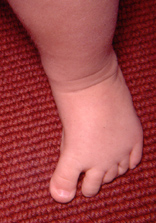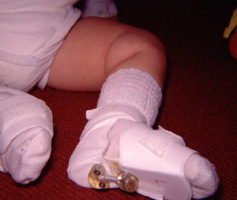
In-toeing and Out-toeing
Questions about in-toeing and out-toeing are among of the most common reasons parents bring their children to see a pediatric orthopedist. The child's parents and often, even more so, the child's grandparents want to know if the way their child walks is normal, and is the in-toeing causing the child to fall more often.
Many parents or their siblings were treated with special shoes or bars for a problem they had with their legs when they were young. Today, more often than not, treatment is not necessary thanks to a better understanding of what causes in-toeing or out-toeing and how these conditions get better over time.
In-toeing arises from one of, or a combination of, three areas; the foot, the leg, or around the hip. Which area is contributing to the in-toeing determines the likelihood that it will correct over time, and determines up until what age one may expect improvement.
 The outside border of the foot should make a straight line. In a
condition called metatarsus adductus, the front part of the foot will curve inward. The outside border of the foot will then also be
curved inward. This leads to the child walking with his or her toes pointing in. Metatarsus adductus is a condition usually diagnosed before the child is walking. It is most often treated with stretching
exercises as long as it is flexible or the foot can be
The outside border of the foot should make a straight line. In a
condition called metatarsus adductus, the front part of the foot will curve inward. The outside border of the foot will then also be
curved inward. This leads to the child walking with his or her toes pointing in. Metatarsus adductus is a condition usually diagnosed before the child is walking. It is most often treated with stretching
exercises as long as it is flexible or the foot can be  placed in a normal position. Occasionally,
the stretching is done using reverse last shoes, which are meant to stretch the inside of the
foot as they are worn. Even with stretching, a small amount of metatarsus adductus may persist in the walking child, but it is rarely of any clinical significance. Casts have been used but newer adjusting shoe-like bootie
braces do the same thing and can be used for the follow up as well.
placed in a normal position. Occasionally,
the stretching is done using reverse last shoes, which are meant to stretch the inside of the
foot as they are worn. Even with stretching, a small amount of metatarsus adductus may persist in the walking child, but it is rarely of any clinical significance. Casts have been used but newer adjusting shoe-like bootie
braces do the same thing and can be used for the follow up as well.
A more common contributor to in-toeing is a condition called internal tibial torsion. This is a term for an internal twist in the tibia. This is often a normal finding in a newborn. It is caused by the baby's position in the womb prior to birth. Usually, the baby's legs are folded over each other giving them an inward twist. With growth this twisting will tend to correct itself. Occasionally, a child who is still walking will still have internal tibial torsion, which causes the feet to point inward when the knees face straight ahead. The Denis-Brown bar ("D-B bar") was once used to treat internal tibial torsion quite often. It consists of a bar connected to a pair of shoes, which are turned outward. Wearing the bar is supposed to help rotate the tibias outward. It is not used very often anymore because studies have demonstrated that internal tibial torsion tends to get better up until the age of four to six years old. Children wearing the bar have no better outcome than children who do not wear the bar. So why wear it at all? The bar is considered only in severe circumstances, such as complicate club foot.
The third area where in-toeing arises is around the hips. The condition is called femoral anteversion. When a hip can rotate inward much more than outward, femoral anteversion is present. These are children who have trouble sitting cross-legged but find it easy to sit with their legs behind them in a "W" fashion. The internal twist about the hips translates to in-toeing when walking because having the hips turned in a little is a comfortable position for these children. Femoral anteversion, as with tibial torsion, tends to get better on its own. It can correct until the age of eight to ten years.
A great majority of children do not require treatment. Surgery is reserved for severe cases where the in-toeing is affecting the child's function because the only surgery that helps involves cutting the femur or the tibia and rotating it until the toes point forward. This is big surgery, which can have complications.
For both tibial torsion and femoral anteversion, the mechanism of self correction is walking . Normal walking and functional forces cue the workings of alignment. Children who do not walk (for reasons of neurologic problems etc.) do not correct. Those who walk with severe pathologic patterns may actually worsen. Children lacking some other disorder seldom have any problem. In cultures where sitting on the feet is the norm, so are adaptive turns. It does not look bad nor is there any consequence from it.
Out-toeing is much less common. External tibial torsion or femoral retroversion may cause it. External tibial torsion refers to a tibia, which rotates outward, while femoral retroversion refers to a hip, which can turn out more than it can turn in. The treatment principals are similar to those outlined above. One caution, if an older child who was not known to have outward rotation from the start, begins to develop it, then x-rays of the hips are needed including especially a "lateral hip view" to be sure the hip has not slipped.
Interestingly, some people need retroversion. To get it you have to work at it and begin young, very young. A girl who at 14 years of age decides to be a great ballerina just won't get there. The retroverting twist required by that art form, which allows those graceful out -turned moves had to be established skeletally. That means young. Sorry. The growth plate of the upper femur that in the older growing child connects the ball of the femur to the neck of the femur (see SCFE), in the younger child covers the entire femoral neck. When that larger scope of growth cartilage recedes, so does self induced rotation.